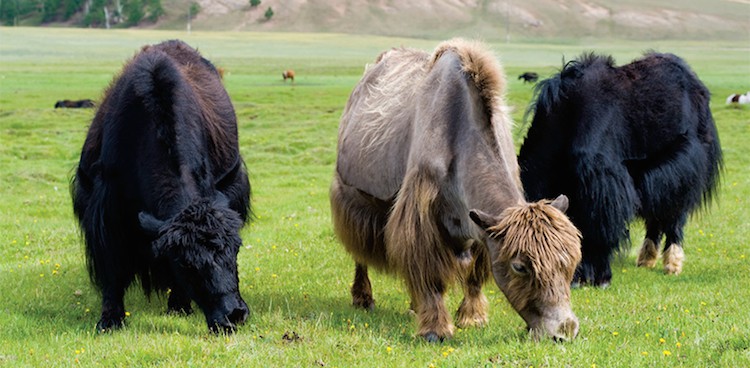
Origin
The domesticated yak (Bos grunniens, “the grunting ox”) is one of the bovine family’s most ancient members. These imposing creatures are the result of crossbreeding between the wild yak that once populated the entire Tibetan plateau and various local cattle breeds.
History
The first domestication likely occurred during the first millennium B.C. For over 5,000 years, this lumbering, hairy creature has provided the nomadic peoples of Tibet, Nepal, and India with a means of prosperity and economic development in a harsh and unforgiving land. These animals are not only an excellent source of rich milk, nutritious meat, valuable wool, hair, hides, and horns but also a means of transporting goods across treacherous mountain passes. As if that were not enough, their dried dung even serves as a source of fuel on the treeless Tibetan plateau.
Appearance
With their hairy coats, shoulder humps, and handlebar horns, yaks project a truly prehistoric image. And with adult yak cows weighing in at 600–800 pounds and yak bulls at 1,200–1,500 pounds, they are certainly not beasts to be taken lightly. Despite their imposing stature, yaks can be quite docile and tractable if habituated to humans from an early age. This makes them a fine choice for small-scale farmers and anyone interested in taking advantage of their skill as pack animals. Yaks are also very “easy keepers.” They eat only about one-third the amount of hay as a commercial cow and are disease resistant and cold hardy. In fact, thanks to their thick coats and low number of sweat glands, yaks have been known to survive in temperatures as low as 40 degrees below zero. For those same reasons they are not well suited to extremely hot or humid climates.
Milk & Cheeses
Known in Tibet for its richness (5 to 7 percent fat), yak milk is appropriate for butter, cheese, and yogurt production. The milk is dense with a creamy color. Despite its tremendous size, the yak cow is not a terribly productive dairy animal, giving only as much milk as an average goat.
Thanks largely to a varied, free-range diet, cheese made from yak milk contains much higher levels of healthy fats compared to cow’s milk cheese. In a study conducted by researchers at Canada’s University of Guelph, cheese from free-range Nepalese yaks was compared to cheddar cheese from grain-fed, Canadian dairy cows. The results indicated that the yak cheese was three times higher in omega-3 fatty acids than the cheddar cheese, and richer in conjugated linoleic acid (CLA)—a type of healthy fat known to have a wide range of positive health benefits.
In Tibet and Nepal, yak milk is most frequently used for a dried, smoked cheese called chhurpi or sherkam. And while yaks’ unkempt appearance might give the impression that their cheese would be of the strong, pungent variety, fresh yak’s milk cheese is a very delicate-tasting product with flavors that vary with the available forage of the season.




